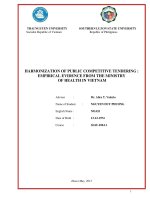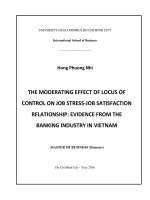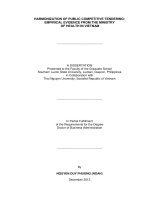DETERMINANTS OF COMMERCIAL BANKS INTEREST RATE SPREADS: SOME EMPIRICAL EVIDENCE FROM THE EASTERN CARIBBEAN CURRENCY UNION pdf
Bạn đang xem bản rút gọn của tài liệu. Xem và tải ngay bản đầy đủ của tài liệu tại đây (337.64 KB, 35 trang )
RESEARCH DEPARTMENT
WORKING PAPERS
DETERMINANTS OF COMMERCIAL BANKS INTEREST RATE
SPREADS: SOME EMPIRICAL EVIDENCE FROM THE
EASTERN CARIBBEAN CURRENCY UNION
by
Kari H I Grenade
March 2007
C
ODE: WP/07/01
EASTERN CARIBBEAN CENTRAL BANK
ECCB
STAFF RESEARCH PAPER WP/07/01
DETERMINANTS OF COMMERCIAL BANKS INTEREST RATE SPREADS:
S
OME EMPIRICAL EVIDENCE FROM THE EASTERN CARIBBEAN CURRENCY UNION
KARI H. I. GRENADE
*
A
BSTRACT:
A trend analysis of commercial banks’ interest rate spreads in the Eastern Caribbean Currency
Union (ECCU) over the period 1993 to 2003 exposes two stylised facts. First, spreads have
been strong and persistently showing little signs of narrowing and second, foreign owned banks
have been operating with larger spreads compared to their indigenous counterparts. This study
employs panel data techniques to measure the relevance of micro and macro factors in
determining commercial banks’ interest rate spreads over the period. The results indicate that
the observed spreads can be attributed to the high level of market concentration, high operating
costs and non- performing loans and the central bank’s regulated savings deposit rate.
JEL Classification Numbers: E43, E44
Keywords: ECCU, Interest Rate Spreads, Commercial Banks
*
Kari Grenade has been employed as an Economist in the Research Department of the ECCB since 2004. Her email
address is
. Gratitude is expressed to the staff of the Research Department,
Wendell Samuel, Delisle Worrell and Fritz Van Beek for their useful comments and suggestions.
Disclaimer:
The Eastern Caribbean Central Bank (ECCB) strongly supports academic freedom and a researcher's
right to publish and encourages such activity among its employees. However, the ECCB as an
institution does not endorse the viewpoint of an employee's publication or guarantee its technical
correctness. The views and opinions expressed in this paper are solely those of the author(s) and do not
necessarily state or reflect those of the Eastern Caribbean Central Bank. No part of this publication
shall be used for advertising or product endorsement purposes.
Table of Contents
1.0
INTRODUCTION 1
2.0 LITERATURE REVIEW 2
3.0
INTEREST RATE SPREADS IN THE ECCU: 1993 – 2003 4
3.1 Ex-ante Spreads: 4
3.2 Ex-post Spreads: 8
4.0 DATA SOURCES AND MEASUREMENT 11
5.0 ESTIMATION TECHNIQUES 17
6.0 EMPIRICAL RESULTS 19
7.0 DISCUSSION OF RESULTS 21
8.0 CONCLUSION/RECOMMENDATIONS 24
REFERENCES 26
APPENDICES 28
List of Tables
Table 1: Ex-ante Spreads in the ECCU and Selected Countries 4
Table 2A: Ex-ante Spreads in the ECCU – Foreign versus Indigenous Banks 6
Table 2B: Ex-ante Spreads in the ECCU – Foreign versus Indigenous Banks 7
Table 3A: Ex-post Spreads in the ECCU – Foreign versus Indigenous Banks 9
Table 3B: Ex -post Spreads in the ECCU – Foreign versus Indigenous Banks 10
Table 4: Key Variables and their expected Impact on Interest Rate Spreads 11
Table 5: The HHI – Foreign versus Indigenous Banks 17
List of Figures
Figure 1: Ex ante spreads – Foreign versus Indigenous Banks 5
Figure 2: Ex post spreads – Foreign versus Indigenous Banks 8
Figure 3: HHI - Total Banking Sector
16
List of Abbreviations
AUG – Anguilla
ANT – Antigua and Barbuda
DOM – Dominica
GREN – Grenada
MON – Montserrat
SKN – St Kitts and Nevis
SLU – Saint Lucia
SVG – St Vincent and the Grenadines
ECCU – Eastern Caribbean Currency Union
BDS - Barbados
TNT - Trinidad and Tobago
US - United States of America
UK - United Kingdom
1
1.0 I
NTRODUCTION
The high interest rate spreads of the commercial banking industry in the currency union have
emerged as a key public policy issue. Commercial banks are the main source of business
funding in the ECCU, therefore, the level of interest rate spreads is an important policy
variable. Interest rate spreads indicate how efficiently banks perform their intermediation role
of savings mobilisation and allocation. Large interest rate spreads are deemed to be inimical
to economic growth, as they act as a disincentive to private investment and otherwise constrain
it to suboptimal levels. Inefficiencies in intermediation may emerge from structural problems:
lack of adequate competition, scale diseconomies due to small market size or high fixed
operating costs, the existence of regulatory controls, perceived market risks and the
unsoundness of banks.
There are two approaches to measuring interest rate spreads. The ex- ante approach and the
ex- post approach. The ex-ante interest rate spread is the difference between the contractual
rates charged on loans and the rates paid on deposits. These are the rates that the public sees
and are easily comparable across banks. The ex-post spread is the difference between the
average rate charged on loans and the average rate paid on deposits. The average rate charged
on loans is calculated by dividing total interest income received on loans and advances by the
average stock of loans and advances, while the average rate paid on deposits is calculated by
dividing total interest expense by the average stock of total deposits. The behaviour of both the
ex-ante and the ex-post spreads is examined. In most empirical studies, the ex-post spread is
the one commonly used as the dependent variable. Demirguc-Kunt et al (1999), argue that the
ex–post spread is a more encompassing and useful measure because it controls for the fact that
banks with high yields and risky credits are likely to face more defaults.
The purpose of this study is to provide an econometric account of some of the main
determinants of the ex-post interest rate spreads of commercial banks. The paper uses pooled
annual data of all the commercial banks operating in the ECCU over the period 1993 to 2003.
This empirical analysis is the first step towards a serious and informed policy discussion on
feasible options to narrow spreads. This paper extends the literature by including regulatory
2
variables and a market power variable to determine their influences on bank spreads in the
ECCU. Additionally, determinants of interest rate spreads are analysed separately for the
aggregate banking system and for the foreign and indigenous banks. Previous work done on
ex-post interest rate spreads in the ECCU focussed on high operational costs through
diseconomies of scale as the most relevant factor in determining bank spreads (Randall, 1998).
The paper is organised as follows; section 2 reviews the empirical literature while section 3
provides an overview of the developments in interest rate spreads in the ECCU over the study
period. Section 4 describes the data while section 5 deals with the estimation techniques.
Section 6 presents the empirical results, section 7 discusses the policy implications of the
results and Section 8 concludes.
2.0
LITERATURE REVIEW
The Hanson and Rocha (1986) study was one of the earliest investigations of the factors
determining large spreads that began with the concern that a large spread was an impediment
to financial intermediation. The thinking was that it discouraged potential savers with low
returns on their savings and potential investors with reduced feasible investment opportunities.
Using aggregate data of 29 countries over the period 1975 – 1983, Hanson and Rocha (1986)
attributed high operating costs, financial repression, lack of competition and high inflation
rates as the main causes of the high spread.
Chirwa et al (2004) used panel data techniques to investigate the causes of interest rate spreads
in the commercial banking system of Malawi over the liberalised period of the 1990s. Their
results show that high interest rate spreads were attributable to monopoly power, high reserve
requirements, high central bank discount rate and high inflation. Demirguc-Kunt et al (1999)
using bank level data for 80 industrial and developing countries over the period 1988-1995
show that differences in interest margins reflect a variety of determinants such as bank
characteristics, macroeconomic conditions, explicit and implicit bank taxes and the overall
financial structure.
3
Barajas et al (1998), examine the sources of high intermediation spreads observed in the
Colombian banking sector over the pre liberalisation period (1974- 1988) and the post
liberalisation period (1991-1996) and found mixed results. Liberalisation increased banking
sector competitiveness, lowered market power and reduced financial taxation from its high
1970s level. The results also show bank spreads to be more responsive to non-financial costs
(wages) and changes in loan quality. Afanassieff et al (2000), using panel data techniques to
uncover the main determinants of bank spreads in Brazil, found that macroeconomic factors
are the most relevant in explaining the spreads. Ramful (2001) in his study of the Mauritian
banking sector found that interest rate spread was used not only to cover the cost of operating
expenses and required reserves but also reflected the high degree of market power among
banks and the poor quality of loans.
For the wider Caribbean, Moore and Craigwell (2000), using panel data techniques,
empirically assessed some of the major determinants of commercial banks’ spreads over the
financially liberalised period of the 1990s and found that market power, provision for loan
losses and real gross domestic product to be significant factors influencing bank spreads.
As it specifically relates to the ECCU, Randall (1998) devised two approaches to explain
various determinants of interest rate spreads. In the first approach, using 24 quarterly
observations for each of the countries over the period 1991-96, an accounting framework was
formulated to decompose spreads into shares of various components. Using two-stage least
squares methodology, the coefficients of parameters were obtained. However, her framework
was purely descriptive and lacked any behavioural content, which she duly acknowledged. In
the second approach Randall (1998) tested a set of variables, which were expected a priori to
have an effect on the spread and found that operating costs were a key determinant of interest
rate spreads accounting for 23 per cent of the estimated spread.
There has been very little empirical study done in the ECCU investigating the causes of large
bank spreads since Randall (1998). This study attempts to fill this gap by bring the issue of
large spreads to the fore once more with a view to stimulating discussion on measures that
will cause interest rate spreads to narrow.
4
3.0 INTEREST RATE SPREADS IN THE ECCU: 1993 – 2003
This section presents an overview of the magnitudes of both ex-ante and ex-post spreads for
the aggregate banking system as well as the foreign and indigenous banks over the study
period.
3.1 Ex-ante Spreads:
i) Aggregate Banking System
As table 1 shows, over the study period, ex-ante spreads for the ECCU as a whole have been
persistently higher than those of the UK and USA averaging 7.6 percentage points compared
with 2.5 and 2.8 percentage points for the UK and USA respectively. However, the issue of
high spreads is not unique to the ECCU, as large spreads are also found in Trinidad and
Tobago and Barbados.
Table1: Ex-ante Spreads in the ECCU and Selected Countries
(Percentage Points)
5
0.00
1.00
2.00
3.00
4.00
5.00
6.00
7.00
8.00
9.00
10.00
1993 1994 1995 1996 1997 1998 1999 2000 2001 2002 2003
Years
Percentage Points
Foreign Banks
Indigenous Banks
Table 1 shows that over the review period ex-ante spreads were most pronounced in
Montserrat with spreads averaging 9.1 percentage points, followed by Anguilla, 8.0
percentage points. Average ex-ante spread was the lowest in Grenada (7.0 percentage points)
followed by St Kitts and Nevis with 7.1 percentage points. In some countries ex-ante spreads
fluctuated quite a bit. The rate of variation was most outstanding in Grenada and Saint Lucia.
In Grenada, spreads fell from 7.9 percentage points in 1993 to 5.9 percentage points in 2001
increasing again to 8.5 percentage points in 2003. In Saint Lucia’s case, spreads declined
from 8.5 percentage points in 1993 to 6.5 percentage points in 1997 and rose again to 8.6
percentage points in 2002. For the other ECCU countries, the differences in the deposit and
loans rates, though striking, did not vary as much.
ii) Foreign versus Indigenous Banks
Figure 1: Ex-ante Spreads - Foreign versus Indigenous Banks
6
Table 2A: Ex-ante Spreads in the ECCU – Foreign versus Indigenous Banks
(Percentage Points)
7
Table 2B: Ex-ante Spreads in the ECCU – Foreign versus Indigenous Banks
(Percentage Points)
As shown in figure 1, over the study period foreign banks in the ECCU had consistently
higher spreads than their indigenous counterparts. As tables 2A and 2B show, these higher
spreads were most evident in six of the eight ECCU countries. For example, interest rate
spreads of the foreign banks in Dominica averaged 8.1 percentage points as compared with 6.5
percentage points for the indigenous banks. In St Kitts and Nevis, spreads averaged 8.6
percentage points for the private banks, some 2.9 percentage points higher than the indigenous
banks.
8
0.00
2.00
4.00
6.00
8.00
10.00
12.00
1993 1994 1995 1996 1997 1998 1999 2000 2001 2002 2003
Years
Percentage Points
Foreign Banks
Indigenous Banks
3.2 Ex-post Spreads:
i) Aggregate Banking System
Over the study period interest rate spreads as measured ex-post showed a bit more fluctuation
than the ex-ante spreads. Montserrat experienced the greatest rate of variation with spreads
decreasing from 7.1 percentage points in 1993 to 2.4 percentage points in 1998 and rising
again to 7.1 percentage points in 2002. On average, over the study period ex-post spreads
ranged from 7.3 percentage points in Antigua and Barbuda to 6.1 percentage points in
Montserrat.
ii) Foreign vs Indigenous Banks
Figure 2: Ex-post Spreads - Foreign versus Indigenous Banks
As shown in figure 2, for the ECCU as a whole up until 2002, ex-post spreads for the foreign
banks were generally higher than those of the indigenous banks. Foreign banks tended to have
9
higher spreads overall than their indigenous counterparts. However, from 1997, the trend
exhibited is that of a narrowing of the foreign banks’ spread and a widening of those of the
indigenous banks. This could have been as a result of the entry of Trinidadian banks to the
banking system. Tables 3A and 3B show the magnitude of the spread in each country for both
the foreign and indigenous banks.
Table 3A: Ex-Post Spreads in the ECCU – Foreign versus Indigenous Banks
(Percentage Point)
10
Table 3B: Ex-Post Spreads in the ECCU – Foreign versus Indigenous Banks
(Percentage Point)
11
There are possible explanations for spreads being higher for the foreign banks than for their
indigenous counterparts. Indigenous banks have traditionally catered to the small depositors
and small businesses. In order to attract new depositors, indigenous banks would have had to
offer very competitive rates. In addition, because of state involvement in these banks, credit
may have been extended at interest rates below market value.
4.0
DATA SOURCES AND MEASUREMENT
Annual data of all the commercial banks operating in the ECCU during the period 1993 to
2003 are used in this study. All data were sourced from the Central Bank’s database. Included
in the data set are proxies of the following hypothesised determinants of commercial banks ex-
post interest rate spreads:
Table 4: Key Variables and the Expected Impact on Interest Rate Margin
Variable Proxy Predicted
Coefficient
Sign
Rationale
Regulated
saving deposit
rate
RSD
: saving deposits
Total deposits
Positive
RSF
↑⇒
cost
↑⇒
Margins
↑
Opportunity
cost of non-
interest bearing
reserves
RR: non-interest bearing reserves
Positive
RR
↑⇒
Opportunity
cost
↑⇒
Margins
↑
Liquidity risk
LIQ: Liquid assets
Total assets
Negative
LIQ↑⇒Liquidity risk
↓
⇒ Margins
↓
Operating
efficiency
OC: Operating costs
Total earning assets
Positive
OC
↑⇒
Operating
efficiency
↓⇒
Margins
↑
Provision for
loan losses
PL: Provision for loan losses
Total earning assets
Positive
PL
↑⇒
Cost of bad debts write offs
↑
⇒
Margins
↑
Economic
activity
EA: Real GDP growth Negative
EA
↑⇒
risk of loan defaults
↓⇒
Margins
↓
Market power MP: Herfindahl Index Positive
MP
↑⇒
Competition
↓⇒
Margins
↑
12
i) Regulatory Variables:
Since the establishment of the Eastern Caribbean Central Bank (ECCB) in 1983, commercial
banks have been subjected to regulatory controls, two of which are the interest rate floor on
saving deposits and the reserve requirements.
a) The regulated savings deposit rate
Following Randall (1998), this variable is proxied by the share of savings deposits to total
deposits. The higher the share of savings deposits to total deposits the greater the rigidities
imposed on banks’ cost structure through the statutory minimum savings deposit rate. A
priori, this variable is expected to be positively associated with bank spreads. The hypothesis
is that the floor on savings could be binding i.e set above equilibrium and as such, could create
a situation of excess supply. In other words, the regulated interest rate on savings deposits
may have exerted upward pressure on loan rates and in turn bank spreads by encouraging a
propagation of deposits and as such, adding to the operating costs of banks.
From January 1985 until August 2002, the ECCB had prescribed a 4 percent minimum on
savings deposits. This rate was reduced by one percentage point in September 2002 and has
been at that reduced rate since. The policy to regulate the savings rate was geared to assist
financial intermediation and to reward and encourage savings by depositors and also to ensure
that the real savings rate that depositors received on their investment was positive.
b) The reserve requirements
Commercial banks are required to maintain a certain percentage of total deposits and other
similar liabilities to which reserve ratios are made applicable, as the Monetary Council may
determine from time to time. Whereas reserve requirements are used as monetary policy
instruments to ensure the safety and soundness of the banking system, these non-interest
bearing reserves in essence impose an implicit financial tax on banks thereby reducing
commercial banks revenues. Banks can either pass on this loss of revenue to depositors, who
will receive lower interest rates on deposits, or they can pass it on to borrowers who will face
13
higher interest rates on loans, thereby increasing the spread between the two rates. Over the
study period, the reserve requirement ratio remained unchanged at six per cent. However,
because the reserve ratio is applied to total deposits at a point in time, the dollar amount that
each bank holds with the Central Bank would be different, thus allowing for some variation in
the empirical estimations. As a priori, the sign on this variable is expected to be positive.
ii) Liquidity Risk
Where there is excess liquidity in the banking system, banks’ exposures to liquidity risks is
low and this should contribute to lowering spreads. Liquidity risk is proxied by the ratio of
liquid assets to total assets. The expected sign is negative. Brock and Franken (2002)
found that bank liquidity was associated with lower spreads in Chile.
iii) Bank –Specific Variables
The operating costs and the quality of loans portfolio of the commercial banks are the two
bank specific variables included in the data set.
a) Operating costs
Operating costs arise in processing loans and the servicing of deposits. They are proxied by
the ratio of total operating costs to total earning assets. For the aggregate banking system, on
average, the operating cost as a proportion of total earning assets ranged from 3.0 per cent in
St Kitts and Nevis to 4.7 per cent in Antigua and Barbuda. As it relates to the foreign banks,
five of the eight countries recorded ratios of over 4.0 per cent on average. Indigenous banks
recorded ratios ranging from 2.2 per cent in St Kitts and Nevis to 5.3 per cent in Antigua and
Barbuda on average. According to Moore and Craigwell (2000), international standards
normally identify 3.6 per cent as an average, suggesting that the commercial banks in the
ECCU operate with relatively high intermediation costs. A positive relationship between this
variable and bank spreads is expected.
b) Loan loss provisioning
The ratio of provision for loan losses to total earning assets is used as the proxy for quality of
loans across countries. For the aggregate banking system, on average, this ratio of provision
14
for loan losses to total earning assets ranged from 0.2 per cent in Grenada, Anguilla and St
Kitts and Nevis to 2.6 per cent in Montserrat over the study period. As it relates to the foreign
and indigenous banks, ratios tended to be similar on average except in Antigua and Barbuda
and Montserrat where the ratio of provision for losses to total earning assets was significantly
higher for the foreign banks. This may be attributed to the elevated provision for loan losses
following the volcanic eruption in Montserrat and the devastating hurricanes in Antigua and
Barbuda in the mid-nineties. It may also be the case that the indigenous banks in those
countries applied lower standards. A priori, a positive relationship is expected between this
variable and bank spreads reflecting the notion that banks tend to push the cost of non-
performing loans to customers.
iv) Economic activity
From a theoretical standpoint there is positive relationship between economic activity and
banks spreads. As the economy expands, the demand for loans increases and this in turn can
lead to higher lending rates, which can serve to widen spreads. However, empirical studies
have found mixed results. Randall (1998) in her study of the ECCU found a negative
relationship between economic activity and bank spreads while Moore and Craigwell (2000) in
their study of selected CARICOM countries found a positive relationship. Randall’s rationale
for the negative relationship was that as small open economies, the countries of the ECCU are
exposed to external shocks and are vulnerable to hurricanes and other natural disasters. These
negative economic shocks can seriously affect the banking industry by escalating the total
amount of bad debts in the system. This in turn can exert upward pressure on lending rates and
in turn, banks’ spread (i.e. as incomes fall spreads rise). Moore and Craigwell (2000)
explained that as incomes expand, the demand for loans increases and this in turn may push up
lending rates and consequently bank spreads. Economic activity is proxied by the growth rate
of real gross domestic product. Within the ECCU context, the expected sign is negative.
v) Market power variable
The structure of the market in which banks operate plays an important role in influencing bank
spreads. Economic theory posits that competitive pressures that result from conditions of free
entry and competitive pricing will raise the efficiency of intermediation by decreasing the
15
spreads between deposits and lending rates. Recent empirical studies, Chirwa et al (2004),
tend to support the hypothesis that interest rate spreads are positively related to market power.
That is, the more concentrated the banking industry (i.e. the less competitive) the higher the
banks’ spreads.
This study uses the Herfindahl–Hirschman index (HHI) as the measure of market power in the
banking system in each of the ECCU countries both at the aggregate level and for the foreign
and indigenous banks. The HHI index is a commonly accepted measure of market
concentration. Two factors go into the construction of the index, the number of firms in the
industry and each firm’s market share. The fewer the number of firms in the industry the
easier it is for them to coordinate higher prices. Similarly, the greater the market share that a
firm possesses the easier it is for that firm to set higher prices. The index is calculated by
squaring the market share of each firm competing in the market and then summing up the
resulting numbers. The HHI is expressed as:
n
H = ∑ xi
2
i=1
Where, xi is the market share of firm i and n is the number of firms. In this particular
context, the market share of each bank is calculated as its portion of loans and advances to the
total industry’s loans and advances in its respective country. The HHI can range from close to
zero to one. According to the international standard, a result of less than 0.1 is considered to
be a highly competitive market, a result of 0.1 to 0.18 is considered moderately concentrated
and a result that is greater than 0.18 is considered highly concentrated.
As exhibited in figure 3, over the study period, on an aggregate level, in each of the ECCU
countries the value of the HHI has remained virtually unchanged reflecting a highly
concentrated industry within each country. Notable exceptions are Antigua and Barbuda and
to a lesser extent Saint Lucia. However, when the analysis is dissected as shown in table 4 the
level of concentration that exists among the foreign banks is extremely low reflecting an
16
-
0.10
0.20
0.30
0.40
0.50
0.60
1993 1994 1995 1996 1997 1998 1999 2000 2001 2002 2003
AUG
ANT
DOM
GREN MON SKN
SLU
SVG
almost perfectly competitive system unlike that of the indigenous banks where there appears to
be a heavy level of concentration.
Figure 3: HHI – Total Banking Sector
Table 4: The HHI - Foreign and Indigenous Banks
17
5.0
ESTIMATION TECHNIQUES
Panel data models are usually estimated using either pooled ordinary least squares (OLS),
fixed effects or random effects. As cited in Ramful (2001), the latter two techniques have
been developed to handle the systematic tendency of individual specific components to be
different for some units. In this study, all three estimation techniques are carried out,
however, the pooled OLS and random effects estimates
2
were not as robust as the fixed effects
estimates; hence a fixed effect model is utilised. Demirguc-Kunt et al (1999) point out that
while it is possible to estimate panel models using OLS, the conditions under which OLS will
produce consistent estimates are limited and unlikely to be met in practice. Pooled OLS
assumes a constant slope and intercept across all countries. However, the fixed effects model
2
Results not reported
18
involves the recognition that this assumption may be unreasonable. Dummy variables are
therefore introduced to allow the intercept term to vary over time and across countries. The
fixed effects model takes the following form:
I
ijt =
β
o
+ β
1
RS
ijt
+ β
2
RR
i
jt
+ β
3
OC
i
jt
+
β
4
PL
i
jt
+ β
5
MP
jt
+ β
6
GDP
jt+
LQ
i
jt
δ
t
T
t
+ γ
j
C
j
+ ε
ijt
(1)
Where Iijt is the ex-post spread for bank i in country j at time t. RS
ijt
is the regulated rate on
savings deposits of bank i in country j at time t, RR
i
jt
is the required reserve of bank i in
country j at time t, Oc
i
jt is the operating cost of bank i in country j at time t,
PL
i
jt
is the
provision for loan losses of bank i in country j at time t, MP
jt
is the market structure of the
commercial banking sector in country j at time t, GDP
jt is the growth rate of real gross
domestic product of country j at time t and
LQ
i
jt
is the ratio of liquid assets to total assets of
bank i in country j at time t. T
t and Cj are time and country dummy variables and εijt is the
white noise error term.
The empirical estimation of equation 1 is carried out in two ways. First, using aggregate
banking system data, fixed effects pool regression is used to provide common coefficient
estimates of all the explanatory variables for ECCU as a whole. Second, fixed effects pooled
regressions with the operating costs, provision for losses and the gross domestic product
variables being
3
cross section specific coefficients are employed to generate estimates of the
level of these variables for the foreign and indigenous banks separately. All regressions are
estimated using the seemingly unrelated method (SUR) as the weighting option. This method
corrects for both cross section heteroscedastiscity and contemporaneous correlations. Further,
all estimations are done using iterative two-stage least squares to account for any endogeneity
among the variables. The econometric estimation has been carried out using EVIEWS 5.0.
3
The regulatory, liquidity and market power variables are not used as cross section specific variables since they
exhibit minimal variation across countries. The regulatory variables are both administered by the common monetary
authority and the HHI is virtually similar in all countries.
19
6.0
EMPIRICAL RESULTS
The results from the panel regression analysis on the factors that influence bank spreads in the
ECCU are reported in tables 5 to 7.
i) Common Coefficient Estimates – Total Banking System
The results in table 5 show that the market power variable is positive and is the most
significant variable at the one percent level. The coefficient indicates that the aggregate
banking sector in the ECCU did have some degree of market power in setting interest rates
which tended to raise interest rates spreads by 10.46 percentage points on average over the
study period citurus paribus.
The empirical estimates show that there is a positive and significant relationship between the
regulated savings deposit rate and interest rate spreads. The coefficient of 0.48 implies that
over the study period, the statutory minimum deposit rate has raised interest rates spreads in
the ECCU by 0.48 percentage point on average over the study period. Randall (1998)
hypothesised that the minimum savings deposit rate may have triggered a proliferation of
deposits and as a consequence, exerted upward pressure on bank spreads by raising marginal
interest costs and possibly banks operating costs.
The positive and statistically significant coefficient of 0.01 on the GDP variable suggests that
as national income expanded in the ECCU countries the demand for loans also increased. This
resulted in banks charging higher lending rates and thus raising the region’s average interest
rate spread by 0.01 percentage points.
The estimation results show that the coefficient on the reserve requirement variable is
significant at the one percent level but is incorrectly signed. On the surface this result seems
highly counterintuitive. However, it could be that banks are counting liquidity as part of their
reserves. Given that excess liquidity exists in the banking system, banks exposure to liquidity
risks is low and this may contribute to narrower spreads. The negative and significant
coefficient on the liquidity risk variable strengthens this point.
20
Both the operating cost and provision for loan loss variables are positive and significant at the
one percent level confirming the well known assertion that banks operating with high costs due
to diseconomies of scale and /or costs associated with bad debt write offs, must operate with
high spreads to cover those costs.
ii) Cross Section Specific Estimates – Foreign Banks
Table 6 presents the results when the operating cost, provision for loan losses and the GDP
variables are estimated as cross section specific variables using the data of the foreign banks.
Of the three cross section specific variables, the operating cost variable is significant and
positive in six of the ECCU countries implying that increasing operating costs of the foreign
banks contribute to higher spreads in those countries. It could be the case that head office
overheads are being spread over too few branches. In Montserrat and Saint Lucia the
coefficients on the operating cost variable are negative but not significant. The coefficient on
the provision for loan loss variable is significant and positive only in Montserrat, the result
may be indicative of the high levels of loan defaults, which resulted following the natural
disasters that occurred during the study period. The escalation of loan defaults would have
resulted in banks pushing up their lending rates to cover the cost of bad debt write offs which
would have resulted in higher spreads. Anguilla and Saint Lucia had negative and significant
coefficients suggesting that banks in those countries may be under provisioning. The
coefficient on the GDP variable is significant and positive in Antigua and Barbuda and
Montserrat and significant and negative in Dominica, Grenada, Saint Lucia and St Vincent and
the Grenadines.
Of the common coefficient variables, one salient result is the negative and strongly significant
coefficient on the market power variable. This result is not surprising. The rationale is that
the more competitive the banking system, the harder it is for banks to coordinate higher prices
and this contributes to lower spreads. The HHI shows a low level of market power among the
foreign branch banks; in other words there is not a significant departure from a perfectly
competitive system. The parameter values of the other three common coefficient variables are
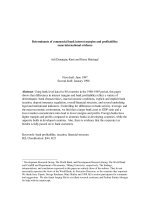

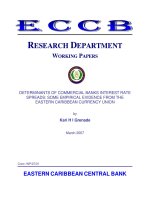
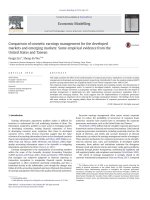

![kwon et al - 2014 - the effect of mandatory audit firm rotation on audit quality and audit fees empirical - evidence from the korean audit market [mafr]](https://media.store123doc.com/images/document/2015_01/06/medium_har1420548188.jpg)
